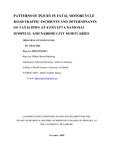| dc.contributor.author | Adera, Oigo | |
| dc.date.accessioned | 2019-01-30T06:00:34Z | |
| dc.date.available | 2019-01-30T06:00:34Z | |
| dc.date.issued | 2018 | |
| dc.identifier.uri | http://hdl.handle.net/11295/105933 | |
| dc.description.abstract | Background: Fatal road traffic incidents (RTIs) are of global concern accounting for the highest cause of death among the young productive age of 15-49 years. Low and middle income countries (LMIC) being the worst hit despite having lower motorization in comparison to developed countries. The rise in RTIs is also attributable to the increased use of two wheeled motor vehicle, which are a cheaper and more convenient mode of transport. Previous studies done on morbidity and mortality of motorcycle associated accidents have shed some light into preventative measures to reduce such occurrences. Locally the Transport and Safety authority has implemented laws governing safe use of motorcycles, like helmet and reflector jacket use and despite the knowledge and traffic laws governing this, fatalities from two wheeled motor vehicles are still on the rise. This raises concerns about possible contributing factors leading to such high fatalities, whether pre-crash, crash or post-crash factors. There is minimal information locally on autopsy studies on patterns of injury in fatal motorcycle RTIs. This study is designed to establish these patterns and link them to possible contributors to fatalities and provide insight and recommendations that may be applied to try and reduce these injuries and fatalities.
Objective: The main objective of this study was to determine the patterns of injury and contributing factors to mortality among fatal motorcycle RTIs.
Study design: Descriptive cross sectional autopsy study.
Study area: Kenyatta National Hospital (KNH) mortuary and Nairobi City Mortuary (NCM).
Study population: All decedents of fatal motorcycle incidents at KNH and NCM who met the eligibility criteria.
Materials and methods: This was a descriptive autopsy study, involving decedents of fatal motorcycle RTIs at the KNH mortuary and NCM. Enrolment was through informed consent from the next of kin. A well-structured questionnaire was duly filled for information relevant to the study from both the police and next of kin. An autopsy was then carried out by the PI under supervision to identify and describe the injuries sustained and determine any related complications. Findings were documented in a proforma questionnaire, data collection sheets and photographs. The injuries sustained by the decedents were tabled and a severity score calculated using the injury severity score (ISS) calculator and also abbreviated injury score (AIS) for the head and neck injuries sustained.
xiii
Results: Males were the majority 91.67%, females were 8.33%. Their age ranged between 16 and 37 years with a median of 30 years (IQR=24-33) for decedents at NRM, and between 17 and 88 years with a median of 30 years (IQR=25-43) for decedents at KNH. Riders accounted for the majority of fatalities 70.8% while pillions were 29.2%. All the riders were male. Frontal and rear – end impacts were the commonest, accounting for 83.3%.
Saloon cars accounted for the most of the collision objects 37.5%, while buses accounted for 9.7% and had 100% mortality within 24 hours. Accidents due to road bumps, road barriers, potholes and tyre bursts accounted for a good number of deaths that occurred after 168 hours of hospital stay.
Helmet use was noted in 26.4% of the decedents riders being the most 84.2% as compared to 17% pillion riders. Head injury was the most commonly reported finding occurring in 86.1% of the victims. Other injuries reported included neck 25%, thorax 23.6%, lower limb 22.2%, abdomen 16.7% and the upper limb 8%.
Conclusion
Head and neck injuries were the most frequent and severe injuries sustained, combined with abdominal and chest injuries accounted for majority of fatalities within 24 hours. Helmet use was very low and even when worn protection from head injury was minimal. Frontal and rear impacts were the commonest considering that most MCIs occurred on major highways with Mombasa road, Thika road and Kiambu road recording the larger proportions. Majority of the incidents occurred over the weekend and mostly in the evenings or wee hours of the night. Saloon cars were the commonest collision objects while buses, matatus and trucks were associated with higher ISS scores, abdominal and thoracic injuries and fatalities within 24 hours | en_US |
| dc.language.iso | en | en_US |
| dc.publisher | University of Nairobi | en_US |
| dc.rights | Attribution-NonCommercial-NoDerivs 3.0 United States | * |
| dc.rights.uri | http://creativecommons.org/licenses/by-nc-nd/3.0/us/ | * |
| dc.subject | Patterns of Injury in Fatal Motorcycle Road Traffic Incidents | en_US |
| dc.title | Patterns of Injury in Fatal Motorcycle Road Traffic Incidents and Determinants of Fatalities at Kenyatta National Hospital and Nairobi City Mortuaries | en_US |
| dc.type | Thesis | en_US |
| dc.description.department | a
Department of Psychiatry, University of Nairobi, ; bDepartment of Mental Health, School of Medicine,
Moi University, Eldoret, Kenya | |



